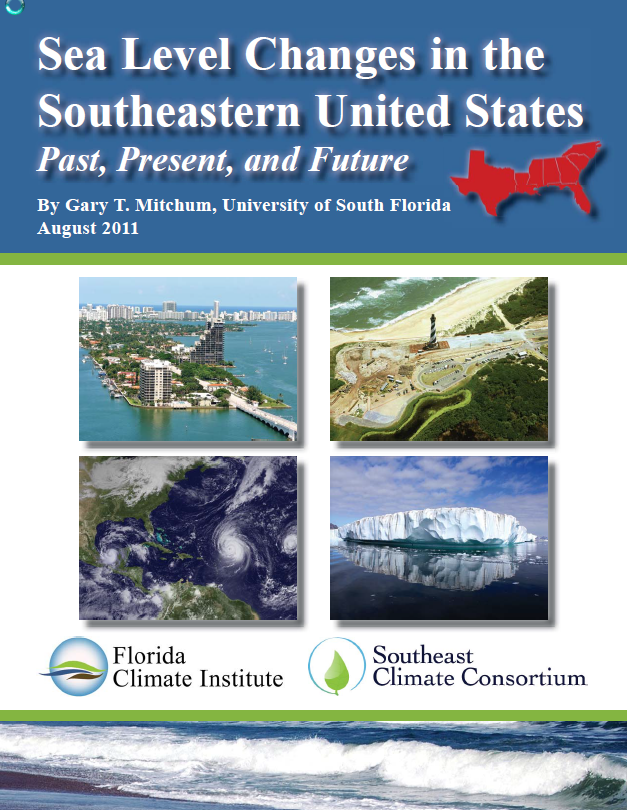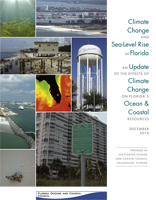The science related to changing sea levels and the impacts of sea-level rise can be confusing. This page offers links to trustworthy summaries of science on sea level that are more accessible to those, like local government planners and attorneys, that are not specialists in sea-level rise science but who need to understand the likely amount of sea-level rise and how this may impact their region.
1. Sea-Level Rise Q&As
Sea-Level Rise in Florida–the Facts and Science
This short “fact sheet” is organized as a series of basic questions and answers. It provides a four-and-one-half page summary of sea-level change and sea-level rise science for Florida. It begins by putting changing sea levels in the context of millions of years of our changing planet. The fact sheet then looks at more recent increases in sea levels, predictions for further increases, how sea-level rise will impact Florida, and how Florida is responding to rising sea levels.
2. Sea-Level Rise Science
Sea Level Changes in the Southeastern United States: Past, Present, and Future
This document–directed at non-scientists and scientists not expert in sea-level rise–gives excellent background on the basic physics behind changing sea levels and examines the state of the science in future predictions for sea levels in Florida. Two main conclusions of the document: 1) the current best estimate of the author is for sea level in Florida to rise about 80 centimeters (31 inches) by 2100 and 2) the amount of uncertainty in this prediction should decrease dramatically during the next 10 years of data collection and analysis.
United States Army Corps of Engineers Sea-Level Rise Guidance Document
The U.S. Army Corps of Engineers in the Department of the Army issued its first sea-level rise guidance document in 2009, re-issued very similar guidance in 2011, and on December 31, 2013 issued a regulation superseding the 2011 guidance document. The regulation discusses the science on which sea-level rise estimates are based and instructs that all activities of the Civil Works division of the U.S. Army Corps of Engineers incorporate sea-level rise into the management, planning, engineering, designing, constructing, operating, and maintaining of U.S. Army Corps of Engineers projects. This guidance documents details the methodology the U.S. Army Corps of Engineers uses to create three different scenarios of sea-level rise to use when evaluating projects. The high scenario uses a 1.5 meter (about 5 feet) estimate of global sea level rise from 1990 to 2100. The medium and low scenarios are 1.0 meter (39 inches) and 0.5 meter (about 20 inches) respectively. The formulas provided allow the user to integrate actual time of construction and location-specific information to improve the scenarios used. The Army Corps has a website that allows users to enter information that allows creation of custom curves for sea-level rise based on the Army Corps methodology. The website is available here.
In addition to the regulation above and “Sea-Level Change Curve Calculator,” the U.S. Army Corps of Engineers developed a technical letter titled “Procedures to Evaluate Sea Level Change: Impacts, Responses, and Adaptations.” The draft technical letter may be found here. The technical letter gives in-depth treatment to issues of how to understand and estimate changing sea levels and how the Corps makes decisions.
IPCC Climate Change 2013: The Physical Science Basis, Summary for Policymakers
The Intergovernmental Panel on Climate Change (IPCC) is the world’s most authoritative body on climate change and the science of sea-level rise. The IPCC AR5 report “Climate Change 2013: The Physical Science Basis, Summary for Policymakers” is the work of over 250 authors/scientists from 39 countries and responds to over 50,000 comments received on the draft report. The report here is a 28-page summary of a full document that stretches out to 1,552 pages. The draft report contains specific sections on both oceans and sea-level rise.
 3. Sea-Level Rise Impacts
3. Sea-Level Rise Impacts
Climate Change and Sea-Level Rise in Florida: An Update on the Effects of Climate Change on Florida’s Ocean & Coastal Resources
The Florida Ocean and Coastal Council developed this document that examines a number of the effects of sea-level rise on Florida.
Climate Change: Evidence, Impacts & Choices
Published by the National Research Council, Part II of this booklet focuses on the impacts of climate change and sea-level rise.
